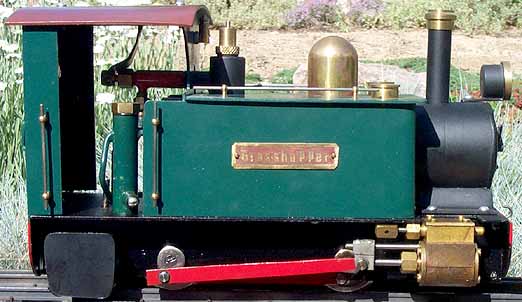
Back to Loco of the Month homepage
Back to Sidestreet Bannerworks
.
July 2004
Geoffbuilt 0-4-0T
by Marc Horovitz

Geoff Coldrick built engines commercially under the trade name of Geoffbuilt from the late 1980s through the 1990s. Originally from Liverpool, England, Geoff was a longtime resident of Salisbury, New Brunswick, Canada. He spent most of his earlier years modeling in HO, but later discovered 16mm scale and live steam.
Geoff’s engines were all freelance. They were built around standard Roundhouse parts, including boilers, cylinders, and fittings, while Geoff made all the chasses and bodywork himself. His line included (at various times) the 0-4-0T discussed here, a Shay (which used oscillating cylinders), a Forney, and others, all in gauge 1.
What is not so well known is that he also offered a line of wooden rolling stock for a while, both in kit form as well as built up. These were also freelance, and pretty basic in their construction. They were supplied unpainted and provided a good basis for additional detailing and finishing. Both freight and passenger stock was available, all supplied less trucks and couplers. This line was discontinued in 1991.
Grasshopper is a basic, generic, British-style 0-4-0T. It is heavily constructed (the cab, for instance, is 1/16" plate). Powered by alcohol, the burner has four wicks. Boiler fittings include only a throttle and safety valve, the latter being removed to fill the boiler. the cab roof does not come off, but access to the throttle is easy. There is a fuel filler pipe in the cab as well as a large displacement lubricator. Reversing is via slip eccentrics. Side tanks are fitted with handrails and dummy hatch covers. The siderods appear to have been sheared from a piece of plate, a couple holes drilled for the crankpins, and a coat of paint applied—crude but effective.
The run
Run day was toasty, with the temperature in the low 80s. BTUs from the sun always helps an engine's performance. Grasshopper was oiled all around in the approved manner and vital fluids dispensed to their appropriate receptacles. The engine was set on the track and the fire ignited. Steam came up quickly—less than 5 minutes. I opened the throttle and off it went without even a push.
Grasshopper is easily controlled, the throttle being accessible from the left cab door. It quite happily ran at a sedate speed, without train, for lap after lap. The engine has a loud exhaust beat, which adds to its charm.
A large alcohol tank is provided and, even with four wicks, the engine ran for a full half hour before fuel had to be added. Pot-boilered engines with large fuel capacity typically have long durations. I remember Dave Rowlands writing back in the 1980s about his Archangel locomotives, some of which would run for well over an hour with just an occasional topping up of meths. When he had gardening to do, Dave would fire up an engine to keep him company, letting it run around his line all by itself while he did his work. Grasshopper is a good candidate for this kind of run, too.
.
|
|
|
| Builder | Geoffbuilt (Canada) |
| Date built | 1993 |
| Gauge | 45mm |
| Scale | 16mm |
| Boiler | Pot |
| Fittings | Safety valve, throttle |
| Fuel | Alcohol |
| Blow-off pressure | 40 psi |
| Cylinders | Two, double-acting D-valve |
| Reversing gear | Slip eccentrics |
| Lubricator | Displacement |
| Dimensions | Length, 9-1/2" over the end beams; width, 4-1/4"; height, 5-7/8" |


Plain lines and a workmanlike finish characterize Geoffbuilt locomotives. Cab and tanks are made from relatively heavy plate.
.

Right: The underside is reminiscent of early Roundhouse locomotives, with their lateral rocker arms to bring the motion through the frame. Four wicks power the boiler. Slip eccentrics are on the rear axle.


Below: Rods look like they were just sheared off a piece of plate. Note the square end.
.


Back to Loco of the Month home page
Back to Sidestreet Bannerworks home page
This page and its contents
Copyright Sidestreet Bannerworks, 2004